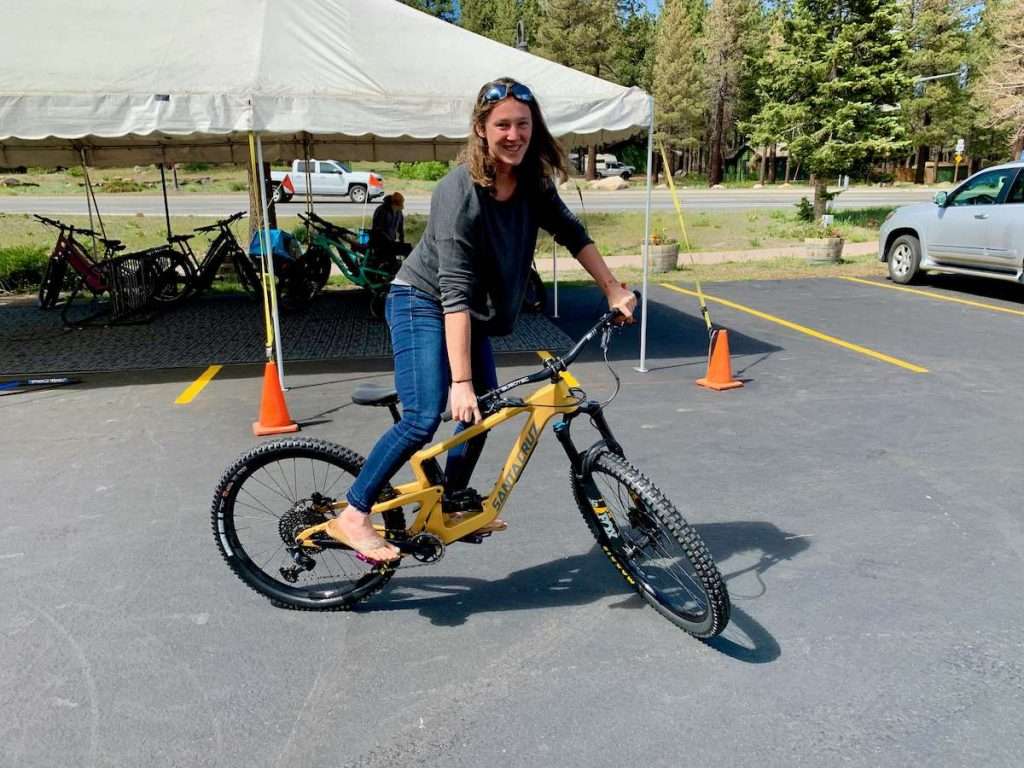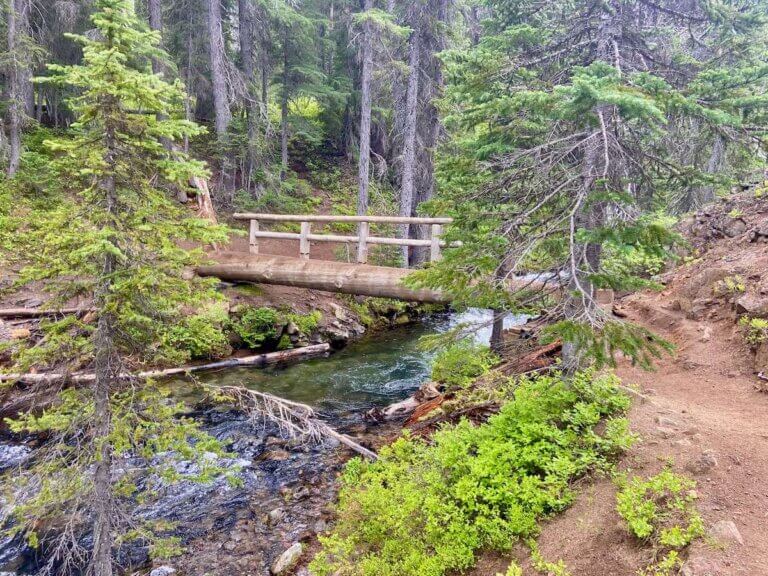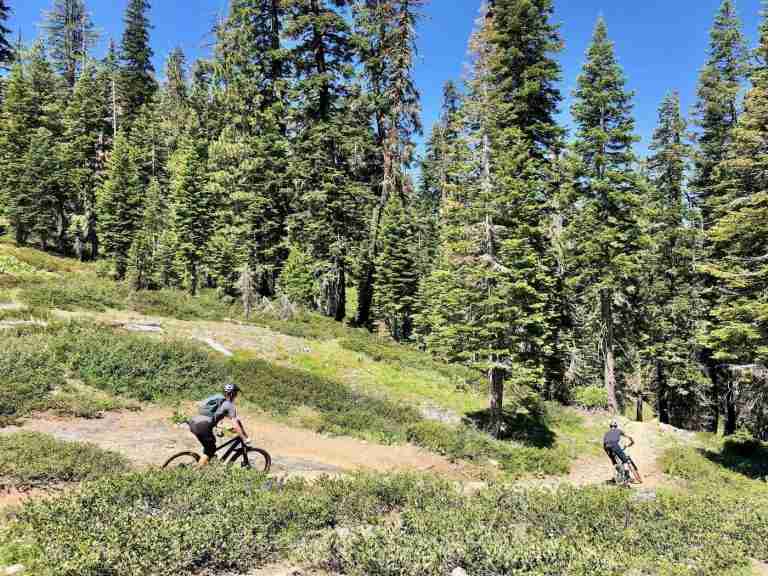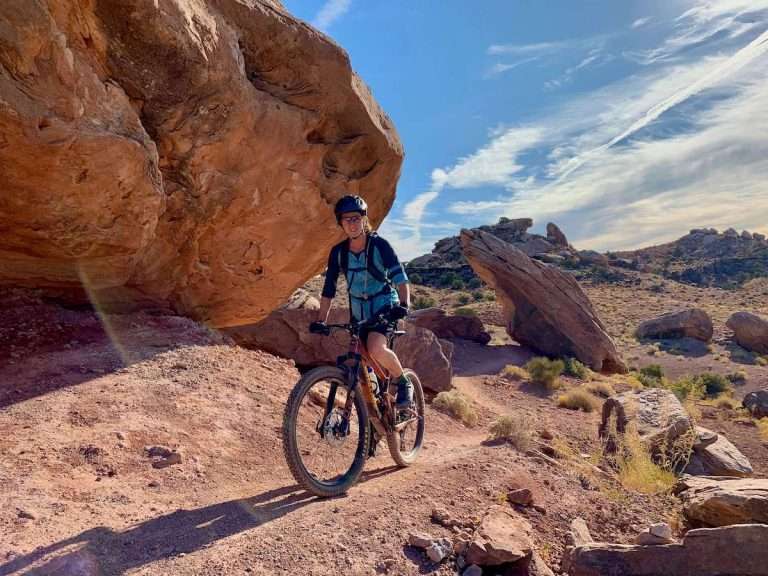7 Questions To Ask When Buying A Used Mountain Bike
Learn the best tips for buying a used mountain bike including what questions to ask, red flags to look for, where to shop, and more.
Looking for tips on how to buy a used mountain bike? Whether you’re looking for your first mountain bike or you want a higher-end build without paying top-dollar prices, buying a used bike is a great way to go for a lot of people.
Many of us drive around in used cars, right? So why not buy a used bike?
Before you go out and spend your money on that shiny new-to-you set of two wheels, though, it’s important to know that, unlike the used car market, there are no guarantees that the used bike you’re about to buy is in tip-top shape.
Has it been serviced and maintained regularly? Are the components in good working order? Will it need a full tune-up?
Unless you’re buying from a reputable bike shop that overhauls used bikes and resells them (like The Pro’s Closet!), you’ll need to do your due diligence to make sure you’re getting a fair (and safe) deal.
So to help you out, in this post, I share my best tips and advice on how to go about buying a used bike including what questions to ask, specific things to look for on the bike, and the best places for shopping around.
Let’s get rolling!
7 Questions to ask
Asking questions is always helpful. This is especially true if you don’t know anything about the used bike you’re looking at.
There are tons of questions you could ask, but the below are 7 are a great place to start when researching how to buy a used mountain bike.
1) Have the shocks been serviced or rebuilt?
Both the front fork and rear shock of a mountain bike need to be serviced regularly to keep them working smoothly and efficiently.
Servicing a shock involves changing the oil, cleaning or replacing the seals, and swapping out the foam rings.
Depending on the shock manufacturer (i.e. Fox or RockShox), most forks and shocks should be serviced around 50-100 hours of riding. It’s a great idea to ask the seller if and/or when the shocks have been last serviced.
In addition to servicing both shocks, they should also both be rebuilt – or overhauled – about once a year or every other year (this depends entirely on how much use and abuse the bike gets).
A rebuild usually involves sending the shock or fork back to the manufacturer or a third-party company (such as Dirt Labs) to be thoroughly taken apart, cleaned, and rebuilt.
If the used bike that you’re looking at is a couple of years old and the shocks have never been serviced or rebuilt, it’s not a deal-breaker, but know that you will probably need to put some money into getting the shocks serviced and overhauled, which can run about $150-200 per shock.
If the bike is more than a few years old and the shocks have never been serviced, it’s probably a good idea to keep looking.
2) When were the brakes bled last?
Bleeding the brakes involves removing air bubbles from the brake lines. These bubbles can interfere with braking power and efficiency.
Bleeding the brakes is a standard part of regular mountain bike maintenance and if the seller knows exactly when the brakes were bled last it probably means that he or she has kept on top of bike maintenance.
If they don’t know when the brakes were bled last it’s not a deal-breaker, but I would look more closely at the other parts of the bike to assess wear and use and whether other components look dirty and worn.
It’s hard to tell if brakes need to be bled unless you take the bike out for a real ride, but if they feel ‘mushy’ or ‘soft’ when you squeeze the brake levers then it’s probably an indication that they need to be bled.
You can bleed brakes yourself with a bit of help from YouTube and a bleed kit (SRAM or Shimano) or any bike shop will do it for you as part of a full tune-up.
3) Are all the components original? If not, why?
Original components aren’t necessarily optimal or even better, but if the bike doesn’t have the original components installed it’s a good idea to find out why.
- Has the seller swapped them out for cheaper (or better) components and if so is the bike priced accordingly?
- Did the bike have a bad crash and did some of the original components need to be replaced? (In this case, make sure you look closely at the frame and parts for other damage).
It’s not a deal-breaker in the least when buying a used mountain bike if the seller swapped out some parts, but it’s just a good idea to understand why they did.
4) Are the tires set up tubeless?
All the cool kids are riding tubeless tires these days. Just kidding 😉 But really, any mountain bike that you buy nowadays should either be set up as tubeless already or tubeless-ready, meaning that the wheels have rim tape installed.
Not sure what tubeless means? Tubeless tires are exactly what they sound like – there are no inner tubes between the rim and the tire. Instead, the tire has a small amount of sealant inside that clogs up punctures and holes as they happen.
With tubeless tires, flats happen waaay less often and you don’t need to deal with pumping up annoying inner tubes (although you should still carry one in your pack).
5) Can I see the serial number?
This is a biggie. Bike theft is a thriving business and you want to make sure you’re not buying a stolen bike. Ask to see the serial number then head to Bike Register or Bike Index to see if anything pops up.
If the seller doesn’t want to show you the serial number or give you their receipt that shows they purchased the bike, that’s a big red flag.
Check in with your inner moral compass to see if you’re really ok buying a stolen bike.
6) Why are you selling it?
It’s ok to ask the seller why they’re selling their bike. When I sold my last one it was because I felt like I had outgrown its capabilities.
Maybe they’ll be truthful to you and maybe not, but it’s a good question to ask regardless.
7) Can I take it for a test ride?
Always take the bike for a little ride if you can, even if it’s just a pedal around the parking lot. Check that the shifting works smoothly – both up and down the cassette – the height and reach feel like a good fit, there are no creaks or funny noises, the dropper post works (if it has one), and the suspension feels smooth and fluid.
If you’re buying a used bike online sight unseen and can’t take it for a ride, be extra diligent about doing research about that specific bike model, asking questions, and requesting more photos if needed.

Red Flags to Look For When Buying A Used Mountain Bike
In addition to asking questions, there are a few specific things you should look for on the bike to make sure it’s in good condition and safe for you to ride.
The first 3 items on this list are big red flags when it comes to buying a used mountain bike. If you see any frame damage walk away. If the bike doesn’t fit right (i.e. you need a medium instead of a large) don’t pull the trigger. If the wheel rims have significant dents or cracks, it’s probably not going to be worth the purchase.
The other seven points are just things to be aware of. If the brake pads are worn down that doesn’t mean you shouldn’t buy the bike. Instead, look at these seven points as indicators of whether the bike was well-cared for and whether you’re getting a fair price for it.
Check for Frame Damage
Thoroughly inspect the bike frame to make sure there aren’t dents or cracks, especially if it’s a carbon bike. If you see any cracks in the paint (chips are ok if it’s just the paint) or if a spot feels ‘mushy’, that is a sign that the frame is damaged.
If there’s damage, walk away.
Aluminum bikes are a little more resistant to frame bashing, but you still don’t want to buy a bike with significant dents or dings.
Make sure the bike is your size
It’s a good idea to know your general bike size before setting off to see a bike or else it’ll be a waste of time – both for you and the seller. You don’t want to buy a bike that doesn’t fit you correctly.
Most bike manufacturers will have charts on their websites to help you determine what size frame you’ll need. The below chart is a sizing chart from Santa Cruz bikes, but all bike manufacturers should have one on their website.

Check the rims for dents & cracks
Make sure you inspect the wheel rims for dents and cracks. Most rims are going to show some wear in the form of scratches and small dings, but you want to make sure there are no significant dents or any cracks.
Also, run your fingers along the spokes to make sure they’re not loose or pulling away from the nipples on the rims.

Is there movement or creaking in the bottom bracket?
When you hop on the bike to take it for a test ride, listen for any creaking in the bottom bracket (where the pedal cranks attach to the frame).
If you do hear creaking, this could be an indicator that the bearings need replacing. It could also just be dirt or water in the pivots, so ask the seller about past bottom bracket maintenance or rebuilding.
It’s not a deal-breaker if the bottom bracket creaks, but try to get as much information as you can about the bike’s maintenance history to help determine if the creaking could be a bigger issue in the future.
Also, check for movement in the bottom bracket. You can do this by taking one pedal in each hand and seeing if there is any movement – however slight – when trying to resist them against each other or move them side-to-side.
What does the chain & cassette wear look like?
Chains aren’t super expensive, but it would be a bummer to buy a used mountain bike and then immediately have to replace the chain without knowing that it was overly worn.
Check the chain wear by either using a chain wear indicator or flexing the links back and forth to see how much movement there is. If the chain links flex significantly and you see a lot of grease and grime build-up, it’s probably time for a new chain.
If you still want the bike, ask for $30-40 off the price so that you can buy a new chain.
For cassettes (or the chainrings) each ‘tooth’ on the cassette should be evenly rounded or look like a tabletop. As they get worn, the teeth start taking on a shark fin look or get pointy on one side. This indicates that the chainring is worn and it’s time for a new one.
Front chainrings cost anywhere from $40-100+ while a whole new rear cassette can run from $80-400+ depending on how high-end you go. The image below shows a very worn cassette.

Assess the brake pads
Check both the front and rear brake pads to see how much wear they have. If the pads are almost down to the plate, then it’s time for them to be replaced.
Brake pads cost about $20-25 per set, so negotiate the bike price if you see that the pads are overly worn.
(You don’t need to remove the pads to see if they’re worn. Just look at them through the brake calipers on the front and rear rotors).
Run through the gears and check the derailleur hanger
Take the bike for a little test pedal and shift the chain up and down the cassette to check whether the shifting is smooth and efficient.
If the chain skips a gear or doesn’t want to shift up or down it’s not the end of the world. You may just need to adjust the derailleur a bit which you can do yourself or take it to a shop.
You also want to check to make sure the derailleur hanger is not bent. This is the little piece of metal that connects the derailleur to the bike frame.
It’s actually meant to be bent or broken in a crash in order to protect the derailleur, which is a lot more expensive to replace.
But a bent hanger can interfere with shifting, so double-check to make sure that it’s not bent.

Assess tire wear
Look at the knobs and sidewalls of the front and rear tires to see how much wear and tear they show. If the center treads look worn down and the side cornering knobs are torn up and ‘wiggly’ then it’s time for new tires. Good tires run about $80-100 each, so make sure the bike is priced accordingly!
Also, check the condition of the tire rubber. Bikes that have been sitting in storage for a long time, especially in extreme temps, can have tires with cracked rubber. Look closely at them to see what condition the rubber is in.
Check the shock seals
Front and rear shocks need to be serviced regularly and even rebuilt after a season or two of riding.
It’s hard to determine whether shocks have been serviced regularly by just looking at them, but you might be given some clues by looking at the shock seals.
These are the little rubber rings at the base of the stanchions that prevent dust and dirt from contaminating the shock.
If they look cracked or worn, then it’s time for them to be replaced (and probably time for the shocks to be serviced or rebuilt).
Seals are pretty cheap and you can service the shocks yourself if you’re motivated, or a full-service tune-up at a shop will do the job for you.
Check overall cleanliness, especially in pivots and bearings
My final tip when buying a used mountain bike is to just look over the bike as a whole. How clean is it? How worn does it look? Is there a ton of dirt and grime in the pivots and on the chain?
A used mountain bike is going to be used, but it’s not a good idea to invest in one that is on its last legs unless you’re prepared to do a lot of upgrades.
If you’re going to really dive into the world of mountain biking – which I’m confident that you are! – then you’ll want to invest in a decent used bike that is going to last you for a few seasons.
Where to Buy used mountain bikes
Now that you know what questions to ask and what red flags to look for, here are a few places to buy used mountain bikes:
PinkBike
PinkBike is the Craigslist for bikes and you can find everything here from full mountain bikes to wheels, frames, and components.
I’ve used PinkBike to buy all of the above. It’s usually pretty safe to buy on PinkBike, but always use good judgment when sending someone money.
To search for used bikes, head to the PinkBike BuySell area and start browsing! You’ll need to create a free account to contact sellers.
The Pro’s Closet
The Pro’s Closet is located in Louisville, Colorado but they ship nationwide. They have a large selection of pre-owned bikes that has been serviced, inspected, and rated.
The prices on The Pro’s Closet are a little higher than what you would pay if you were to buy directly from the seller, but you also get the peace of mind that you’re buying a fully tuned and inspected used bike.
Gear Trade
Gear Trade is another online marketplace for used gear. While they don’t tend to have a lot of full bikes available, there are usually a couple. This is also a great place to look for wheels or other components if you end up buying just a used bike frame.
Bike Exchange
Bike Exchange is another marketplace for buying a used mountain bike and they have hundreds of listings for mountain bikes as well as other types of bikes and cycling gear.
I’ve never used Bike Exchange, but they’re located in 8 countries across 4 continents, so they do a lot of business! You can buy used bikes from private sellers as well as from bike shops.
Facebook Groups
There are a ton of mountain bike Facebook groups, many of which are locally-based. Search the name of your city or town + “mountain biking” to see if anything shows up. Local Buy, Sell, Trade Facebook groups are also good places to check.
Bicycle Blue Book
Have you heard of Kelly Blue Book for selling cars? Well, there’s a Bicycle Blue Book for selling bikes. You can use this online marketplace to price the worth of your bike or you can check out the dozens of used bikes already available.
Your local bike rental & shop
If you live near a bike shop that offers mountain bike rentals or demos, you might be in luck! These shops typically sell their used rentals or demos at the end of each season so that they can bring in a new fleet the following year.
Ask if and when your shop will be selling their rentals and whether you can buy one.
TIP: Used rental and demo bikes typically get snatched up fast, so it’s a good idea to chat with the shop before the season is over. A lot of times you can ‘claim’ one before it’s actually available
Final thoughts
Buying a used mountain bike can feel overwhelming, but if you use these tips and ask the right questions, you’ll be sure to end up with the perfect bike for you.
Also, remember that it’s good to shop around – the first bike you look at may seem like a great deal but don’t pull the trigger until you’ve looked at a few options.
Good luck!
RELATED POSTS
New to mountain biking? Check out these posts to help you get started:
Do you have experience buying a used mountain bike? Where did buy it from and what did you learn? Leave a comment below!







I love hearing from you and appreciate your comments! However, if you leave a rude, unconstructive, or spammy comment, it will be deleted. It’s cool to be kind. Have an awesome day!